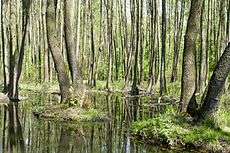Chalcosyrphus nemorum
| Chalcosyrphus nemorum | |
|---|---|
.jpg) | |
| male | |
| Scientific classification | |
| Kingdom: | Animalia |
| Phylum: | Arthropoda |
| Class: | Insecta |
| Order: | Diptera |
| Family: | Syrphidae |
| Genus: | Chalcosyrphus |
| Subgenus: | Xylotina |
| Species: | C. nemorum |
| Binomial name | |
| Chalcosyrphus nemorum (Fabricius, 1805) | |
| Synonyms | |
Chalcosyrphus nemorum is a Palearctic and Nearctic species of hoverfly.[1]
Description
External images For terms see Morphology of Diptera
Wing length 6.5-8.25 mm.
Hind femora are swollen and deep. Hind tibiae strongly curved and the ventral surface with
closely-set short black hairs for the whole length. The abdomen is short tergites 2-4 with a pair of pink or orange-brown marks. The legs are black with yellow knees and yellow tarsi.
[2]
[3]
[4] [5] The larva is figured by Hartley (1961). [6]
Distribution
Fennoscandia South to the Pyrenees and from Ireland East through Northern, Central and Southern Europe (to South Italy) across the Palearctic into Russia and the Russian Far East and Sakhalin and Japan. In the Nearctic from Alaska to Nova Scotia and South to California.[7][8] [9]

Biology
The habitat is forest wetland (Alnus - Salix carr, deciduous forest and woodland with streams). Adults frequent sunlit foliage of bushes on trunks of fallen trees beside water and settle on damp mud at the water's edge.Flowers visited include white umbellifers, Caltha, Anemone nemorosa, Euphorbia amygdaloides, Ranunculus, Rubus idaeus, Potentilla erecta, Sorbus aucupariaand Taraxacum. [10] Flies from the beginning of May to the end of September.[11]
References
- ↑ Stubbs, Alan E.; Falk, Steven J (1983). British Hoverflies: An Illustrated Identification Guide (2nd ed.). London: British Entomological and Natural History Society. pp. 253, xvpp. ISBN 1-899935-03-7.
- ↑ Van Veen, M. (2004) Hoverflies of Northwest Europe: identification keys to the Syrphidae. 256pp. KNNV Publishing, Utrecht.
- ↑ Van der Goot,V.S. (1981) De zweefvliegen van Noordwest - Europa en Europees Rusland, in het bijzonder van de Benelux. KNNV, Uitgave no.32: 275pp. Amsterdam.
- ↑ Bei-Bienko, G.Y. & Steyskal, G.C. (1988) Keys to the Insects of the European Part of the USSR, Volume V: Diptera and Siphonaptera, Part I. Amerind Publishing Co., New Delhi. ISBN 81-205-0080-6.
- ↑ Coe, R.L. (1953) Diptera: Syrphidae. Handbks.ident.Br.insects, 10(1): 1-98. R.ent.Soc.London. pdf
- ↑ Hartley, J.C. (1961) A taxonomic account of the larvae of some British Syrphidae. Proc.zool.Soc.Lond.,136: 505-573.
- ↑ Fauna Europaea
- ↑ Peck, L.V. (1988) Syrphidae. In: Soos, A. & Papp, L. (eds.) Catalogue of Palaearctic Diptera, 8: 11-230. Akad.Kiado, Budapest.
- ↑ Vockeroth, J. R. (1992). The Flower Flies of the Subfamily Syrphinae of Canada, Alaska, and Greenland (Diptera: Syrphidae). Part 18. The Insects and Arachnids of Canada (PDF). Ottawa, Ontario: Canadian Government Pub Centre. pp. 1–456. ISBN 0-660-13830-1.
- ↑ Peck, L.V. (1988) Syrphidae. In: Soos, A. & Papp, L. (eds.) Catalogue of Palaearctic Diptera, 8: 11-230. Akad.Kiado, Budapest.
- ↑ Speight, M.C.D. (2011). "Species accounts of European Syrphidae (Diptera)" (PDF). Syrph the Net, the database of European Syrphidae. 65: 285pp.